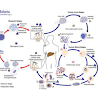Classification of Diseases: Al-Razi
Al-Razi, also known as Rhazes, was a renowned Persian physician, philosopher, and polymath who lived during the Islamic Golden Age in the 9th and 10th centuries. He made significant contributions to the field of medicine, including the classification of diseases.
Al-Razi's classification of diseases was based on his observations and clinical experience. He categorized diseases into several groups, including:
1. Infectious diseases: Al-Razi recognized that many diseases were caused by infectious agents such as bacteria, viruses, and parasites. He classified infectious diseases into different categories based on their symptoms, severity, and transmission modes.
2. Chronic diseases: Al-Razi identified chronic diseases as conditions that persisted over a long period of time and did not resolve spontaneously. He classified chronic diseases into various categories based on their characteristics and manifestations.
3. Genetic diseases: Although the concept of genetics was not fully understood during Al-Razi's time, he recognized that some diseases were hereditary in nature. He classified genetic diseases based on their familial patterns and manifestations.
4. Nutritional diseases: Al-Razi emphasized the role of nutrition in health and disease. He classified diseases caused by nutritional deficiencies or imbalances, such as scurvy, rickets, and beriberi, as nutritional diseases.
5. Mental diseases: Al-Razi recognized that mental health was an important aspect of overall health. He classified mental diseases, including conditions such as depression, anxiety, and schizophrenia, based on their symptoms and manifestations.
6. Environmental diseases: Al-Razi understood that environmental factors could contribute to the development of diseases. He classified diseases caused by environmental factors such as toxins, pollutants, and occupational hazards into a separate category.
7. Lifestyle diseases: Al-Razi also recognized that certain diseases were associated with specific lifestyle choices, such as poor diet, sedentary behavior, and tobacco or alcohol use. He classified diseases associated with lifestyle choices into a separate category.
8. Traumatic diseases: Al-Razi recognized that injuries and trauma could result in various diseases and conditions. He classified traumatic diseases based on the nature and severity of the injury, such as fractures, dislocations, and wounds, and their associated complications.
9. Metabolic diseases: Al-Razi understood that imbalances in metabolism could lead to various diseases. He classified metabolic diseases, such as diabetes mellitus, gout, and hyperlipidemia, based on their metabolic abnormalities and clinical manifestations.
10. Circulatory diseases: Al-Razi recognized that diseases related to the circulatory system, such as heart diseases and vascular disorders, had distinct characteristics. He classified circulatory diseases based on their clinical features, such as chest pain, palpitations, and edema.
11. Gastrointestinal diseases: Al-Razi classified diseases that affected the gastrointestinal system, such as gastric ulcers, colitis, and liver diseases, based on their anatomical location, clinical symptoms, and associated complications.
12. Respiratory diseases: Al-Razi recognized that diseases affecting the respiratory system, such as pneumonia, asthma, and tuberculosis, had unique features. He classified respiratory diseases based on their clinical presentations, severity, and underlying causes.
13. Urinary diseases: Al-Razi understood that diseases affecting the urinary system, such as kidney diseases, bladder disorders, and urinary tract infections, had distinct characteristics. He classified urinary diseases based on their anatomical location, clinical symptoms, and associated complications.
14. Reproductive diseases: Al-Razi recognized that diseases related to the reproductive system, such as infertility, sexually transmitted infections, and menstrual disorders, had specific features. He classified reproductive diseases based on their reproductive anatomy, clinical manifestations, and associated complications.
15. Pediatric diseases: Al-Razi acknowledged that diseases affecting children had unique characteristics. He classified pediatric diseases, such as neonatal conditions, childhood infections, and developmental disorders, based on their age of onset, clinical features, and developmental stages.
It's important to note that Al-Razi's classification of diseases was based on the medical knowledge and understanding of his time, which may not align with modern medical classifications. However, his contributions to the field of medicine, including his classification of diseases, laid the groundwork for subsequent developments and influenced the evolution of medical knowledge and practices throughout history.












0 Comments